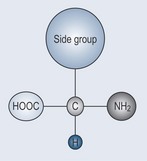Chapter 11 Amino acids and proteins
Amino Acids
Essential and Non-Essential Amino Acids
As with essential fatty acids (see Chapter 10 ‘Lipids’, p. 78) not all amino acids can be synthesized by the body; some have to be taken in with food. They are generally considered essential in children as their metabolism is not mature enough to synthesize them.
Of the 20 standard amino acids that are encoded by DNA (there are considerably more amino acids than this but they are outside the scope of this book), 10 cannot be manufactured by the human body (essential amino acids); the remaining 10 can be synthesized and are therefore known as the non-essential amino acids. Plants contain all 20 amino acids. Their general structure is seen in Figure 11.2.
The essential amino acids (Figure 11.1) are:
The non-essential amino acids are:
Proteins
Proteins serve several functions:
Protein Structure
• Primary (1°) Protein Structure (Figure 11.3)
Polypeptide Cross-Linking
The amino acid cysteine (cys) contains a sulphur group, which can form a cross-link with another sulphur, forming a disulphide bond. This cross-link strengthens the integrity of the polypeptide bond and lends itself to forming a more complex structure (Figure 11.3).

Figure 11.3 The primary structure of shown proteins as a peptide chain with a disulphide cross-link.
Stay updated, free articles. Join our Telegram channel

Full access? Get Clinical Tree




